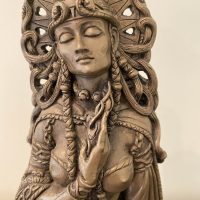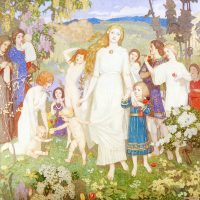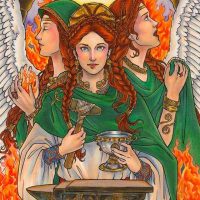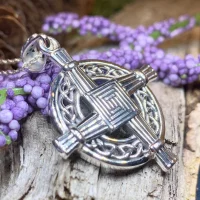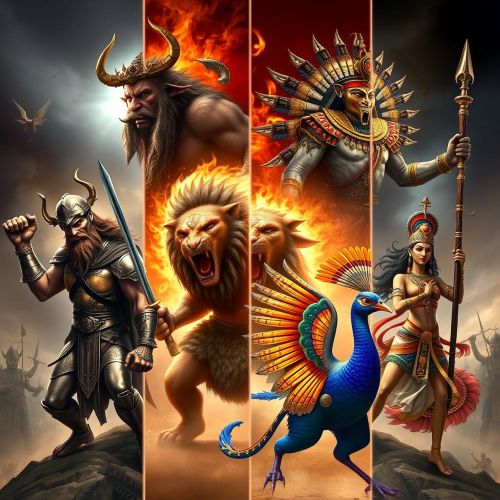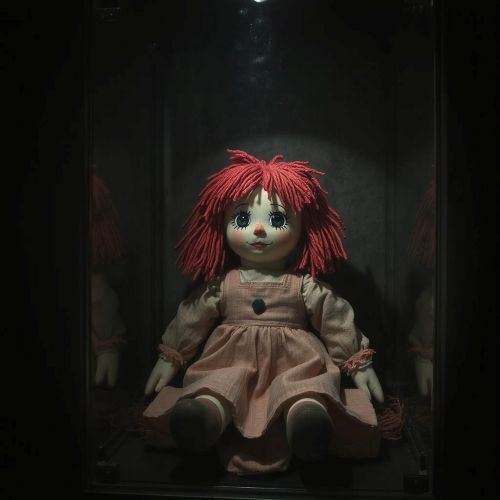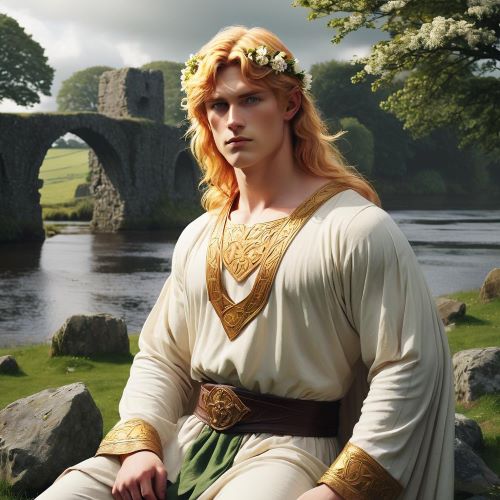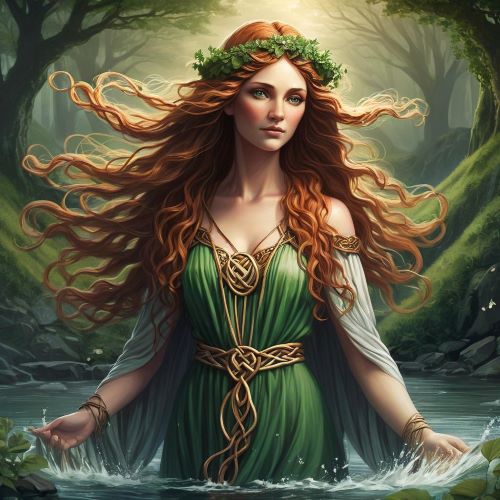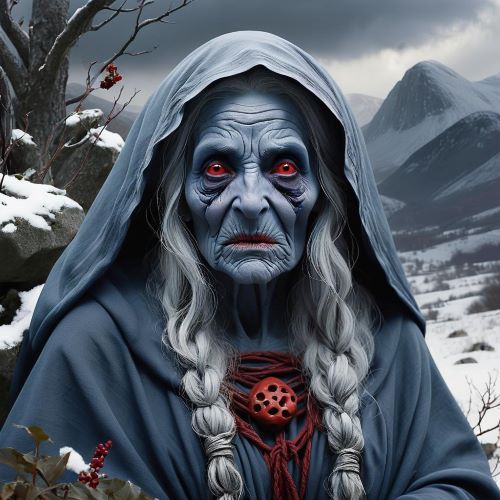Brigid : Goddess of Fire
Listen
At a glance
| Description | |
|---|---|
| Origin | Celtic Mythology |
| Classification | Gods |
| Family Members | Dagda (father) |
| Region | Ireland |
| Associated With | Fire, Poetry, Smithy |
Brigid
Introduction
Brigid, revered by many names including Brigit or Bride, holds a cherished place in Celtic mythology as a member of the Tuatha Dé Danann, the tribe of gods in Irish lore. Associated with healing, poetry, and smithcraft, she encapsulates the fundamental aspects of early Celtic society. Radiant and enigmatic, Brigid’s essence permeates through the ancient tales of Ireland, Scotland, and beyond, leaving an indelible imprint on cultural heritage. As a deity, she embodies a diverse array of attributes, symbolizing fire, poetry, healing, and craftsmanship. Brigid’s significance transcends singular domains; she embodies the flame that kindles hearths, the muse that ignites poets’ inspiration, the healer who brings solace to the ailing, and the guardian of home and its crafts.
Physical Traits
Depictions of Brigid in pre-Christian Celtic narratives are scant, but glimpses of her emerge in later writings and folklore. She is often portrayed as a strikingly beautiful woman, characterized by flowing red hair symbolizing the fiery essence she embodies. Some traditions cloak her in white attire, emblematic of purity and healing, while others depict her as a blacksmith, her robust stature and calloused hands reflecting her association with metalworking.
Radiant and regal, Brigid’s presence exudes warmth and vitality, her fair hair shimmering like polished emeralds, mirroring the vivid hues of nature itself. Occasionally, she is adorned with a crown of flame, emblematic of her affiliation with the transformative power of fire. Through her countenance, Brigid embodies a harmonious blend of strength and compassion, epitomizing the delicate equilibrium inherent in her mythological role.
Though ancient texts offer limited insights into Brigid’s physical attributes, she is commonly depicted as a youthful figure exuding beauty, her fiery locks symbolizing her intimate connection to hearth and home. Often, she is portrayed alongside symbols emblematic of her divine realms, such as a healing well or a forge, further enriching her multifaceted character.
Family
Brigid’s parentage is enshrouded in the mists of Celtic mythology, with variations across different accounts. Widely acknowledged as the daughter of the Dagda, the paramount deity and leader of the Tuatha Dé Danann, her mother remains unnamed in most myths. Intriguingly, Brigid is said to have two sisters bearing the same name, each associated with healing and craftsmanship, hinting at a complex triadic aspect of this divine figure.
The lineage of Brigid offers diverse narratives depending on the source consulted. Some tales depict her as the offspring of the Dagda, a potent god synonymous with fertility and earthly abundance. Conversely, other legends propose a more earthly origin, suggesting Brigid as the daughter of Tuatha Lén, a local chieftain. One particularly captivating myth recounts her emergence from a blazing pillar, a testament to her profound connection to the element of fire.
Other names
Brigid, a figure of multifaceted significance, is recognized by an array of names and titles across Celtic mythology and beyond. In Scotland, she is celebrated as Bride or Brìghde, embodying her enduring connection to fire and vitality. Welsh tradition reveres her as Ffraid, while Christianized narratives often depict her as Saint Brigid of Kildare, blending ancient lore with religious reverence.
In Irish tradition, Brigid is most commonly known as Brigid or Brigit, echoing the Gaelic term “breo-aigit,” signifying the “exalted one” or the “fiery arrow.” This epithet encapsulates her association with both divine inspiration and the transformative power of fire. Across these diverse appellations, Brigid’s essence remains consistent, reflecting her diverse roles and attributes within the rich tapestry of Celtic mythology.
Powers and Abilities
Brigid, a goddess of multifaceted talents, possesses a myriad of powers reflecting her diverse domains within Celtic mythology. Revered for her healing abilities, she can alleviate ailments and restore health. As a patroness of poetry, she channels inspiration and eloquence, enriching artistic endeavors. Her association with smithcraft bestows the transformative essence of the forge, symbolizing innovation and craftsmanship.
Her powers span the breadth of her domains, with fire standing as her quintessential element, embodying warmth, protection, inspiration, and renewal. She possesses the capacity to mend the sick and injured, bless the earth’s bounty, infuse creativity into the hearts of artisans, safeguard homes and families, and oversee metalworking processes.
Central to Brigid’s symbolism is the eternal flame, an emblem of perpetual renewal and ceaseless creativity. Legends speak of her vigil over a sacred fire at Kildare, Ireland, said to never wane, underscoring her status as a guardian of inspiration and innovation. As the patroness of fire, she commands the transformative energies inherent within its flickering flames, embodying both destruction and regeneration. With her innate connection to poetry and inspiration, Brigid ignites the creative fervor within mortal souls, guiding them towards boundless expressions of artistry. Additionally, her mastery of healing arts, steeped in herbal lore and sacred rituals, serves as a beacon of hope and rejuvenation for body and spirit alike.
Modern Day Influence
Brigid’s enduring influence extends far beyond the realms of ancient mythology, resonating profoundly in contemporary society, particularly in her homeland of Ireland. The festival of Imbolc, dedicated to heralding the arrival of spring, stands as a vibrant tribute to her enduring legacy. Throughout Ireland, wells bearing her name serve as tangible reminders of her association with healing waters.
In modern Pagan and Wiccan traditions, Brigid is revered as a guardian of hearth and home, embodying principles of transformation and empowerment. Her symbolic connection to fire continues to inspire practitioners seeking spiritual renewal and enlightenment. Beyond religious observances, Brigid’s presence permeates popular culture, serving as a muse for countless artistic expressions, from literature to music. Her multifaceted character resonates deeply with contemporary audiences, embodying qualities of strength, independence, and resilience.
Featuring prominently in various cultural celebrations and practices, Brigid remains a celebrated figure in modern times. Her feast day on February 1st, marked by bonfires and the crafting of Brigid’s crosses, stands as a testament to her enduring significance. Moreover, Brigid’s archetype serves as a potent symbol for feminist movements, embodying the spirit of defiance against traditional gender norms. As a co-patron saint of Ireland alongside Saint Patrick, her influence extends into religious spheres, with churches and schools bearing her name.
In neo-Pagan traditions, Brigid is revered as a goddess encompassing the interconnectedness of nature, creativity, and healing. Incorporating her into rituals and prayers, practitioners draw upon her timeless wisdom and guidance, embracing her as a source of inspiration and spiritual renewal.
Related Images
Frequently Asked Questions
What is lorem Ipsum?
I am text block. Click edit button to change this text. Lorem ipsum dolor sit amet, consectetur adipiscing elit. Ut elit tellus, luctus nec ullamcorper mattis, pulvinar dapibus leo.
What is lorem Ipsum?
I am text block. Click edit button to change this text. Lorem ipsum dolor sit amet, consectetur adipiscing elit. Ut elit tellus, luctus nec ullamcorper mattis, pulvinar dapibus leo.
What is lorem Ipsum?
I am text block. Click edit button to change this text. Lorem ipsum dolor sit amet, consectetur adipiscing elit. Ut elit tellus, luctus nec ullamcorper mattis, pulvinar dapibus leo.
What is lorem Ipsum?
I am text block. Click edit button to change this text. Lorem ipsum dolor sit amet, consectetur adipiscing elit. Ut elit tellus, luctus nec ullamcorper mattis, pulvinar dapibus leo.
What is lorem Ipsum?
I am text block. Click edit button to change this text. Lorem ipsum dolor sit amet, consectetur adipiscing elit. Ut elit tellus, luctus nec ullamcorper mattis, pulvinar dapibus leo.


